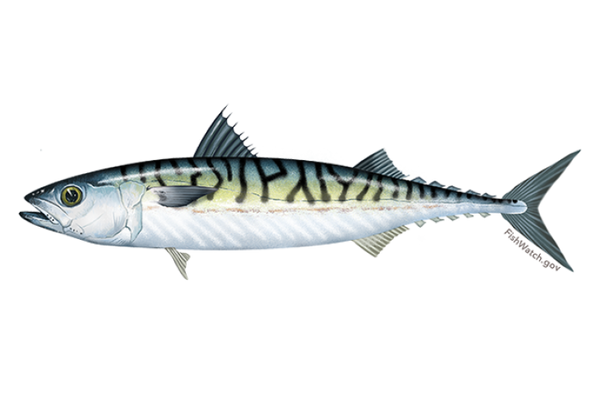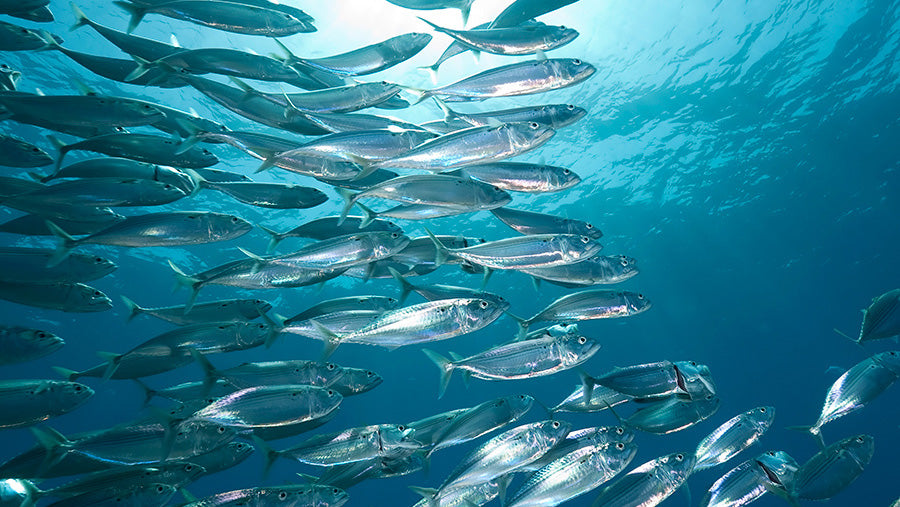Every year the mackerel arrive at Boat Cove in Dawlish following and feeding on the millions of small sprats that shoal in the summer. Catching mackerel and whitebait in the summer is very popular with locals and holiday-makers but what exactly is a mackerel?
Mackerel facts on this page:
What is there to know about the mackerel?
This is what we learned about the Atlantic mackerel, Latin name Scomber scombrus.
- Mackerel are super-fast and can swim 50 metres in 10 seconds!
- The Atlantic mackerel is a fast-swimming schooling open sea (pelagic) fish.
- Atlantic mackerel grow fast, up to 42cm (16½ inches) and 1kg (2.2 pounds).
- Mackerel can live up to 20 years and can reproduce by the time they reach age 2 to 3.
- Depending on their size, females can have between 285,000 and almost 2 million eggs.
- They release their eggs in batches, between five and seven times throughout the spawning season.
- Eggs generally float in the surface water and hatch in 4 to 7 ½ days, depending on water temperature.
- Atlantic mackerel feed a variety of zooplankton, squid and, small fish. They also feed heavily on crustaceans such as copepods, krill, shrimp and sac-like sea creatures called ascidians.
- The mackerel feed wherever they can find food and can feed in the same place from one year to the next.
- Mackerel stop feeding almost completely during winter.
- The Atlantic mackerel was first described in 1758 by the Swedish botanist Carl Linnaeus.
What does a mackerel look like?

- Atlantic mackerel are iridescent (shiny) blue-green on the back with a silvery-white underbelly.
- They have 20 to 30 wavy black bars that run across the top half of their body, and a narrow dark streak that runs below these bars along each side.
- Their body is spindle-shaped, tapering at both ends.
- Their two large dorsal fins (top fins) are grey or dusky. The pectoral fins (side fins) are black or dark at the base, and the tail fin is grey or dusky.
- Their colouring fades quickly after they die.

Why do we catch mackerel?
- Mackerel is sought after for its healthy meat, which is strong in flavour and high in oil content and omega-3 fatty acids among other nutrients.
Where do mackerel live?
- Atlantic mackerel occurs on both sides of the North Atlantic.
- Northeast Atlantic (NEA) mackerel is found in a huge area extending from the Spanish coast in the south to the northern Norwegian Sea, and Iceland and Greenland in the west to the western Baltic Sea in the east.
Mackerel fishing
The mackerel fishing boats in the North Atlantic catch more mackerel than almost any other type of fish. Mackerel is worth more money than many other fish, and by 2021 annual catches have reached approximately 1 million tonnes. As a result of over-fishing, the population of North Atlantic mackerel are reducing.
The future for mackerel
Many organisations are campaigning to protect the fish populations of our oceans such as the World Wildlife Fund (WWF), the Marine Conservation Society (MSC), The Wildlife Trusts and many more.
Go Deeper
Learn more about the Atlantic Mackerel in the resources below.
Atlantic Mackerel. Game & Wildlife Conservation Trust. P. Thompson. 2021. Online. Available at: www.gwct.org.uk
The Atlantic ocean explained. Gibbens, S., 2019. National Geographic. Online, available at: www.nationalgeographic.com
What is the difference between a shoal, a school, and a pod? Dr Scales H., Science Focus. Online, available at: www.sciencefocus.com
Spawning. Fish Habitat Network. 2021. Online, available at: www.fishhabitatnetwork.com.au
Zooplankton. Marinebio.org. 2021. Online, available at: www.marinebio.org
A guide to Squid. The Fish Society. 2021. Online, available at: www.thefishsociety.co.uk
Crustaceans. The Wildlife Trusts. 2021. Online, available at: www.wildlifetrusts.org
Marine Copepods, the Wildebeasts of the Ocean. Mayor, Daniel J., Cook, Kathryn B., Anderson, Thomas R., Belcher, Anna, Jenkins, Holly, Lindeque, Pennie, Tarling, Geraint A., Pond, David. British Antarctic Survey. 2020. Online, available at: www.bas.ac.uk
Carl Linnaeus, Botanist. Sarchet, Penny. New Scientist, 2021. Online, available at: www.newscientist.com
Dorsal Fin/Pectoral Fin. Lynch, Abigail. Fishionary, 2021. Online, available at: fishionary.fisheries.org/dorsal-fin/ | fishionary.fisheries.org/pectoral-fins/
Omega-3 Fatty Acids. 2021. National Institutes of Health. Online, available at: ods.od.nih.gov
North-East Atlantic Regions & The Baltic Sea. United Nations Environment Programme, 2021. Online, available at: www.unep.org
Norwegian Sea Ecoregion. The International Council for the Exploration of the Sea (ICES). 2021. Online, available at: www.ices.dk
Iceland Sea in Bloom. Earth Observatory, NASA. 2012. Online, available at: earthobservatory.nasa.gov
Rich nations continue to overexploit North-East Atlantic fish stocks. Marine Stewardship Council (MSC), 2021. Online, available at: www.msc.org
If you'd like to add or correct anything here please let me know :)
Banner Image: NOAA


